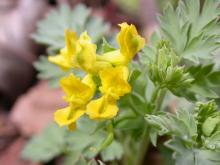Wildflowers, Grasses and Other Nonwoody Plants
Media

Species Types
Scientific Name
Perilla frutescens
Description
Introduced as an ornamental, beefsteak plant is native to Asia. It is common in moist or dry wooded bottomlands, open valley pastures, and along trails, railroads, and roadsides. It spreads invasively in our state.
Media

Species Types
Scientific Name
Cirsium vulgare
Description
Bull thistle is a weedy introduction from Europe, found statewide. To tell it from our other thistles, note its stems with spiny-margined wings, and its leaves with the upper surface strongly roughened with stiff, spiny bristles.
Media

Species Types
Scientific Name
Cirsium altissimum
Description
Tall thistle is a native thistle that can grow to be 10 feet tall! To identify it, notice its leaves, which are unlobed (though they may be wavy or have only shallow, broad lobes), are felty-hairy beneath, and have prickles only along the edges.
Media

Species Types
Scientific Name
Hibiscus lasiocarpos
Description
Hibiscus in Missouri? You bet! Hairy rose mallow is a native perennial whose 6-inch-wide blossoms look a lot like those of its tropical relatives. The stalks can get woody and can grow to 8 feet tall.
Media

Species Types
Scientific Name
Impatiens capensis
Description
Many Missouri children learn about this orange-flowered native plant by playing with the juicy green seedpods, which, when ripe, "explode" upon the slightest touch. This is jewelweed's mechanism for seed dispersal, and it's the reason for the name "touch-me-not."
Media

Species Types
Scientific Name
Impatiens pallida
Description
Our two Missouri jewelweeds occur in the same habitats, often side by side, and even botanists can’t tell them apart without the flowers. Pale touch-me-not is the one with the lemon-yellow flowers!
Media

Species Types
Scientific Name
Trifolium stoloniferum
Description
Running buffalo clover spreads by sending out long, creeping runners. Now endangered, this native perennial once flourished along streams and buffalo trails throughout the grasslands of the eastern and central United States.
Media

Species Types
Scientific Name
Corydalis flavula
Description
The smooth, finely divided, fernlike foliage of pale corydalis is similar to that of the related wildflower Dutchman’s breeches. But in pale corydalis, the small yellow flowers appear tubelike and lipped.
Media

Species Types
Scientific Name
Astragalus crassicarpus (formerly A. mexicanus)
Description
Ground plum is a legume that bears plumlike, edible fruits. Its short, spikelike clusters of pea flowers can be white, cream, yellow, pink, or violet.
Media

Species Types
Scientific Name
Polygonatum biflorum
Description
Solomon's seal grows statewide in moist, rich earth. The greenish-white flowers dangle like little bells beneath the leaves, under the gracefully arching stems.
See Also
About Wildflowers, Grasses and Other Nonwoody Plants in Missouri
A very simple way of thinking about the green world is to divide the vascular plants into two groups: woody and nonwoody (or herbaceous). But this is an artificial division; many plant families include some species that are woody and some that are not. The diversity of nonwoody vascular plants is staggering! Think of all the ferns, grasses, sedges, lilies, peas, sunflowers, nightshades, milkweeds, mustards, mints, and mallows — weeds and wildflowers — and many more!





















